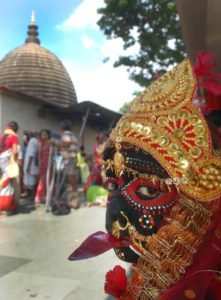Once Lord Buddha was sitting in Sravasti after his daily works when a senior monk by the name of Subhūti approached him reverentially and asked, “How, Lord, should one who has set out on the bodhisattva path take his stand, how should he proceed, how should he control the mind?” The Buddha in the ensuing dialogue tells Subhūti that he will bring all living beings into the state of Nirvana, eventually. He then explains that the Bodhisatva does not see things and people from the eye of the changeful self, but from the prism of perfection of understanding that all phenomenon world is just emptiness. This perfection of insight is called Prajñāpāramitā. He explains via the method of negations that not only is the world essentially empty, but so is merit (or punya), so is dharma, so even is the Buddha. Japanese scholar of Buddhism, Hajime Nakamura, calls this negation the ‘logic of not’ (Sanskrit: na prthak). Looked at in another way, the Buddha’s words were trying to clear the mind of Subhūti of his preconceived ideas and tightly-held notions.
The mind of someone who practices the Prajñāpāramitā or ‘perfection of insight’ is then a mind free from fixed notions or self-concepts. Enlightenment is impossible until all conditions of the mind are broken down.
This discourse became renowed in the world of Buddha dharma as the Vajracchedikā Prajñāpāramitā Sūtra or the Diamond Sūtra. The full name means “The Diamond That Cuts Through Illusion”. Diamond or Vajra is considered in Buddhism as a metaphor representing the nature of Spiritual Insight, for it cuts through illusions and phenomenon just as diamond can cut through almost any common substance. The text remains till date highly popular among Mahayana Buddhists and Zen schools of Buddhism. It creates a tremendous sense of detachment from the world in a seeker who engages in contemplation on the discourse.
The Smithsonian magazine says, “The text was originally discovered in 1900 by a monk in Dunhuang, China, an old outpost of the Silk Road on the edge of the Gobi Desert. The Diamond Sutra, a Sanskrit text translated into Chinese, was one of 40,000 scrolls and documents hidden in “The Cave of a Thousand Buddhas,” a secret library sealed up around the year 1,000 when the area was threatened by a neighboring kingdom.”
The British Librabry considers this manuscript as the earliest complete survival of a printed book.
“So should you view this fleeting world
A star at dawn, a bubble in a stream
A flash of lightning in a summer cloud
A flickering lamp, a phantom and a dream.”


